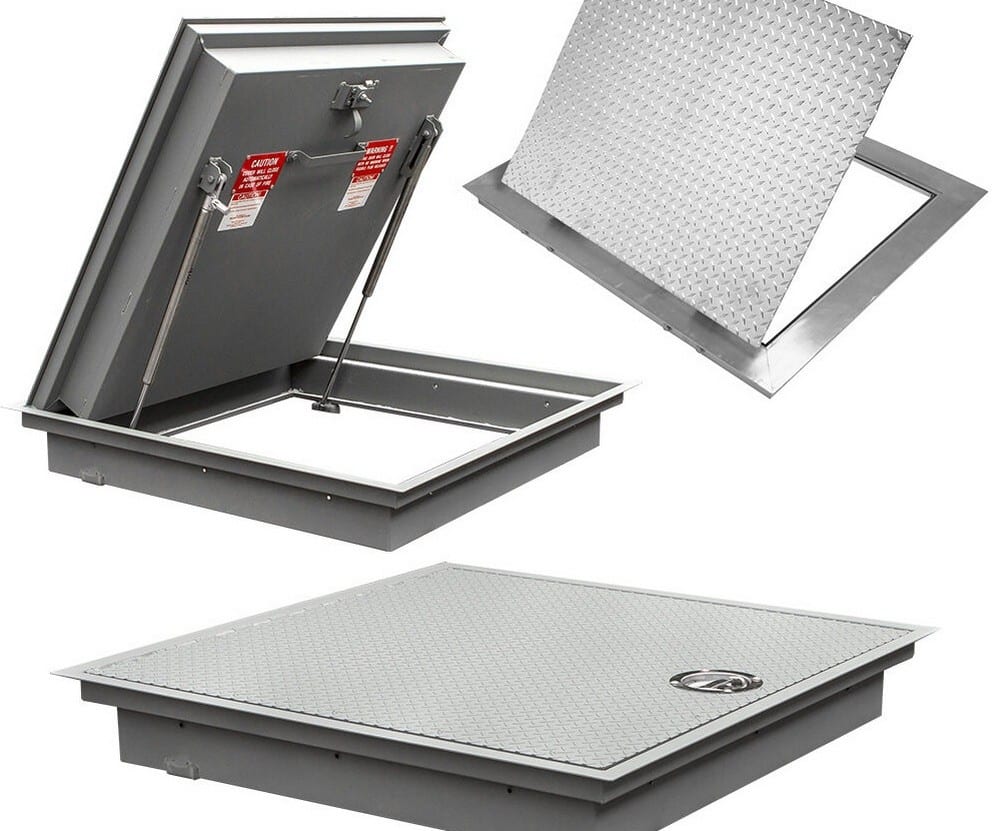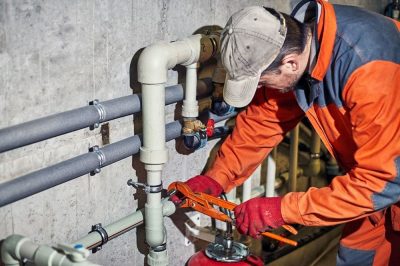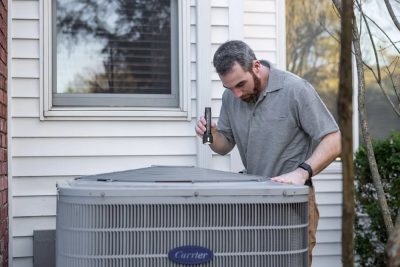Imagine a busy office where employees work, and suddenly, the lights go out due to a faulty electrical connection in the under-floor wiring. Accessing this wiring is a challenge without an easily accessible floor door. The maintenance team may face disruptions like moving furniture or cutting into the floor, which can cause further damage.
This scenario underscores the importance of floor doors, also known as access hatches or panels. They are essential for providing access to vital systems like electrical wiring, plumbing, and HVAC in commercial buildings.

Types of Specialized Floor Doors
Commercial buildings rely on various specialized floor doors to provide access to essential systems and areas. Each type is designed for a specific purpose and features unique attributes and requirements.
H2O Loading Floor Doors, like the BAC-FA-H20 floor doors, provide access to below-floor liquid storage tanks for inspection, maintenance, and cleaning. They are designed to be strong and well-sealed to prevent leaks and structural damage from moisture exposure. Common materials include stainless steel and specialized coatings for corrosion resistance and durability.
PSF Loading Floor Doors measure a floor’s load-bearing capacity in pounds per square foot. In areas with heavy equipment or storage, these doors need reinforcement to handle high PSF loads, distributing weight evenly to prevent floor damage. Common applications include storage rooms, mechanical rooms, and industrial spaces.
Emergency Egress Floor Doors are crucial for safe exits during emergencies. Building codes typically require these doors to meet specific size and location standards to ensure a secure flow of people. They must have specialized locking mechanisms and panic hardware for easy opening from the inside. Clear signage is essential for guiding occupants to these exits, and following local building code requirements is important.
Precast Vaults are used for underground utilities and secure storage. Their floor doors need to be durable and safe for reliable access. Installation and sealing are challenging due to the subterranean environment, making proper sealing essential to prevent water infiltration and keep the vault’s integrity.
Removable Floor Hatches offer an efficient way to access under-floor utilities like plumbing and electrical systems. Designed for easy lifting and removal, they come with various locking mechanisms and lifting systems, depending on their size and weight. Key material considerations include durability, corrosion resistance, and maintenance ease.
Benefits of Properly Installed Specialized Floor Doors
Professionally installed specialized floor doors enhance building operations, safety, and long-term health.
Efficient Maintenance: Easy access to under-floor utilities cuts downtime and labor costs. For example, H2O loading floor doors provide quick access to leaking pipes, while removable floor hatches in data centers allow for swift cabling access. PSF loading doors simplify equipment inspection storage areas without clearing the space.
Enhanced Safety: Floor doors improve safety by providing emergency egress routes and preventing unauthorized access to hazardous areas. Well-designed doors also reduce trip hazards associated with unsafe openings.
Long-Term Building Health: Access hatches ensure proper ventilation under floors, preventing moisture buildup and mold. They protect flooring during maintenance by allowing access without cutting through materials.
Code Compliance: Floor doors often must meet building code requirements for emergency egress and fire safety, ensuring legal protection and occupant safety.
Security: Durable locking mechanisms on floor doors protect sensitive areas from unauthorized access.
Durability and Longevity: Investing in high-quality materials ensures resilience. For example, H2O loading doors may use stainless steel or specialized coatings to resist corrosion, while PSF loading doors require reinforced construction for heavy loads. Selecting the right materials ensures reliable service throughout the building’s lifespan.
Installation Best Practices
Proper installation is crucial for specialized floor doors. Key steps include careful planning, adherence to best practices, and attention to detail.
Planning and Design: During the building design phase, collaborate with architects and engineers to find out the best locations for floor doors and their load-bearing requirements. Ensure compliance with building codes and emergency egress routes while considering the size of equipment that will be accessed.
Installation Procedures: Verify that the opening is the correct size and securely anchor the frame for stability. Use lifting equipment for heavy doors to prevent injury and double-check all measurements. Special techniques may be necessary for sealing precast vault doors.
Sealing and Weatherproofing: Proper sealing prevents water infiltration and air leakage, especially for H2O loading and precast vaults. Use compatible sealants per manufacturer instructions and conduct regular inspections for long-term effectiveness.
Maintenance and Inspection of Specialized Floor Doors
Regular maintenance and inspections are essential for specialized floor doors’ functionality and longevity, helping avoid costly repairs.
Recommended Maintenance Schedules:
- H2O Loading Floor Doors: Inspect for corrosion, leaks, and locking mechanisms annually. Clean regularly.
- PSF Loading Floor Doors: Annual inspection for structural damage and load capacity; check hinges and locks.
- Emergency Egress Floor Doors: Monthly inspections for locking mechanism and panic hardware function; ensure unobstructed access and visible signage.
- Precast Vault Floor Doors: Annual inspection for water infiltration and secure locking mechanism.
- Removable Floor Hatches: Conduct semi-annual inspections for corrosion or damage; check locking and lifting systems.
Inspection Checklists:
- Conduct a visual inspection for damage.
- Check seal integrity and locking mechanisms.
- Inspect hinges and hardware for wear.
- Ensure cleanliness to prevent operational issues.
Repair and Replacement Tips:
- Minor Repairs: Use patching materials for small cracks.
- Seal Replacement: Replace worn seals to prevent leaks.
- Hardware Replacement: Change damaged hinges and locks as needed.
- Professional Assistance: Consult a contractor for major repairs.
- Replacement: For severely damaged doors, replace them with a new unit that meets specifications, consulting manufacturers for specialized doors.
Conclusion
Specialized floor doors are vital in modern commercial buildings, providing access to under-floor utilities essential for maintenance and safety. While quality floor door solutions may have high initial costs, their long-term benefits in efficiency, safety, and building health make the investment worthwhile. Proper planning and maintenance guarantee reliable service throughout the building’s lifespan.








